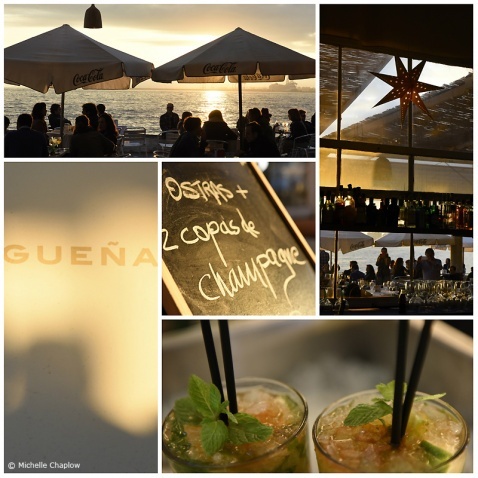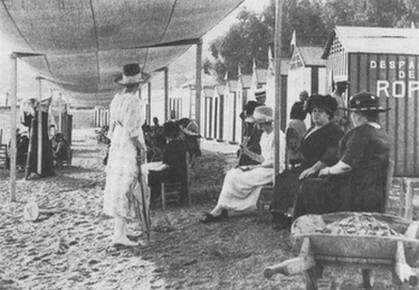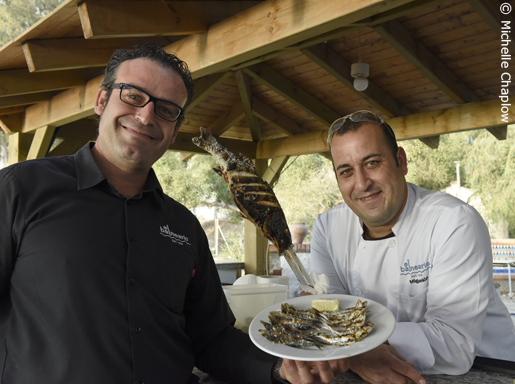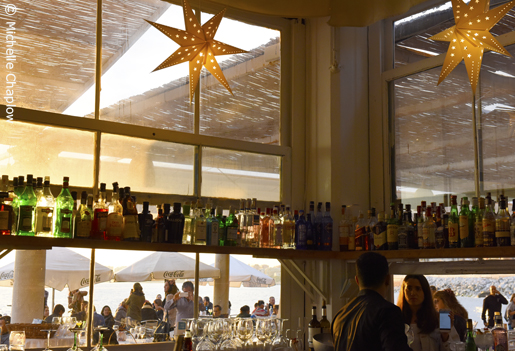
This is one of those shabby-chic locations that you may never want to leave ( click to enlarge) |
|
BAÑOS DEL CARMEN - TERRACE RESTAURANT EL BALNEARIO
The Playa-Balneario Nuestra Señora del Carmen, popularly known as Baños del Carmen, is located on a stretch of seafront east of Malaga city, near the old fishermen's area of El Pedregalejo.
It consists of a small beach, a wooded area, two tennis courts where Malaga's first tennis tournament was held, and a popular restaurant with seafront terrace in the attractive blue and white 1930s pavilion. Public events (concerts, book launches, and press conferences) and private parties (wedding and birthdays) are often held there.
The Baños del Carmen area is semi-abandoned but with a rich history and a certain charm. It is rarely visited by tourists, but those who do find, to their pleasant surprise, both an interesting location and an insight into contemporary Malaga culture. Especially so when an event is taking place, or for free flamenco or other live music on the terrace on weekend afternoons. The sunsets over Malaga city are often spectacular.
HISTORY OF THE BATHS
 |
| Postcard photo of the entrance to Baños de Carmen, which still stands today. |
The Parque-Balneario de los Baños del Carmen was inaugurated on 16 July 1918 as a closed bathing area by Enrque Garcia Toledo, modelled on those in northern Spanish seaside towns Santander and San Sebastian. At that time it was prohibited to bathe on the public beach in daylight. This rule was overcome by closing off the entire area with a high wall and separating women's and men's bathing areas.
Garcia Toledo chose a location just outside the city - already served by three bathing areas near the port: Apolo, La Estrella and Diana which Pablo Picasso remembered frequenting as a child - with a small port, Puerto de la Cantera, which served San Telmo quarry.
It is assumed that the baths' name comes from an old tradition - that one should not bathe in the sea, until the waters have been blessed by Virgen de Carmen - according to Maria Isabel Villa, author of the book La Cultura de Agua: los Baños Publicos en Malaga (The Water Culture: Public Baths in Malaga).
Malaga had a substantial middle class, and many families came from the north of Spain to spend summer in the city, so the Balneario was popular as a meeting place right from the outset.
 |
| Baños del Carmen in a bygone age. Public domain photo provided by Antonio Jurado Navas |
During the following winter, engineer Carlos Loring extended the balneario - new installations included a pavilion with warm water baths, restaurant, 100 family bathing huts, refreshment kiosks, and a 3.500m2 lagoon. The tram company added a new stop outside.
In the third season a jetty was constructed and a large cinema screen, a novelty in those days. Other projects included a football pitch (where Malaga played before La Roseleda was constructed in 1941), amusement park, tennis courts, and a dance hall large enough for 400 couples. There was even a fountain that gushed wine, which was a present from La Vinícola Malagueña, and a small horse-racing track.
The pavilion that survives today was constructed in 1933 by architect Daniel Rubio. It has interesting architecture and was very modern in its day, with Tuscan columns in the entrance walkways and other terraces. The baths were visited by many celebrities including Reina Victoria Eugenia (wife of King Alfonso XIII and daughter of Queen Victoria) who was supporting her two sons in a tennis tournament.
The Baños del Carmen remained open during the Civil War and were even popular in the post-war period. It was not until the Costa del Sol tourist boom in the 1960s that baths started to go out of fashion. In 1982 the Direction General de Puertos y Costas (a national agency to oversee ports and coastline) ruled that all beaches in Spain should be public and removed the concept of a private beach. The owners of Baños del Carmen; "Parque Balneario Nuestra Señora del Carmen SA" were compensated with an unlimited concession to run the installations.
TODAY
As the beach and land are both public, anyone can walk through the open gate into the walled-off area and marvel at the curious nature of the pavilion and surrounding grounds in the woods. Here you will literally trip over historic artefacts, from carved stones to an old aviary, and you can wonder about its former heyday.
The restaurant, Terraza-Restaurante El Balneario de los Baños del Carmen, is open for lunch, afternoon tea, and dinner.
 |
| Fresh fish and warm smiles at Los Baños del Carmen © Michelle Chaplow |
The place appears to be going through a renaissance in popularity for Malaga young and old. Sitting on the terrace on a warm day, whether winter or summer, is very popular as social media will attest (search ‘Baños del Carmen Malaga') for taking sunset selfies.
 |
| Perfect venue for those selfie sunsets © Michelle Chaplow |
Recent additions include an extended terrace up to the sea wall with chill-out lounge furniture, and an-all weather marquee with modern coloured mood-lighting systems. The ample restaurant and café staff are well-trained, offering a surprisingly fast and friendly service for such an aging establishment. The storms in November 2015 seriously flooded the area, but damage has since been repaired.
FUTURE REHABILITATION PLANS
A project was announced in June 2010 by the current Ministerio de Medio Ambiente y la Demarcación de Costas, including regeneration of the beach and park and the reconstruction of the pavilion. Financial constraints have thwarted this plan. The current concession holders proposed a commercial initiative in 2013, including a hotel (outside the grounds) and underground car park, and refurbishment with a botanical garden. The Malaga College of Architects has requested the tendering of different redevelopment ideas. The legal basis of any reconstruction is being challenged in the courts.
Given that there are local, provincial, regional, and national governments involved, plus local historical and environmental groups, any refurbishment project will take some time to be approved.
Eight years after we wrote this page in January 2024 the complex was 'listed' i.e. declared an asset of cultural interest (BIC) by the Junta de Andalucia who have accepted that Baños del Carmen "is the only preserved historical example in Malaga of a public seaside resort" and that the property is an invaluable testimony” of “an important chapter in the history of Malaga, such as the sea bathing culture”.
In September 2023 'Costas' (National Government Agency) appreded the planned creation of a sea wall which will preserve and protect the building from the winter storms. A park to be created on the east side is awaiting aproval by Costas. The Town Hall who applied for the BIC protection will now rehabilitate the restaurant and building, the fate of the Nereo Boatyard is undetermined. The public domain classification of the land is established. The restaurant will close whilst the eatimated 5m€ works are carried out. The resturant, like all Cheringuitos (beach bars) in Andalucia will be run under a term consession title and comercialisation rights.
Getting there
Baños del Carmen is on urban bus routes: 11, 33, 34, N1 and on interurban routes M-161, M-162, M-261, M-262, M-360.
There is limited car parking on the open ground to the east of the pavilion.
Opening Hours
12.00 to 24.00 hrs Monday to Sunday.
Admission free to wander around
Location
Calle Bolivia, 26, Málaga-Este, 29018 Málaga